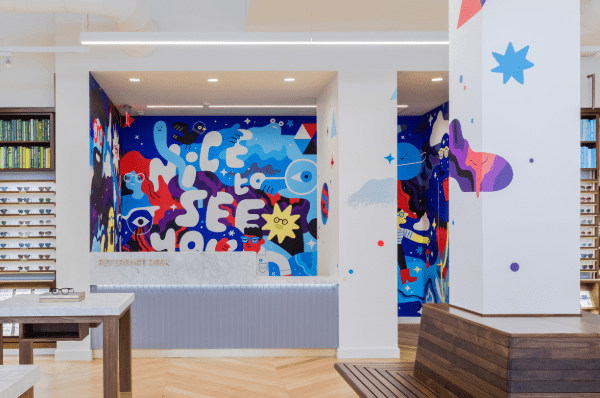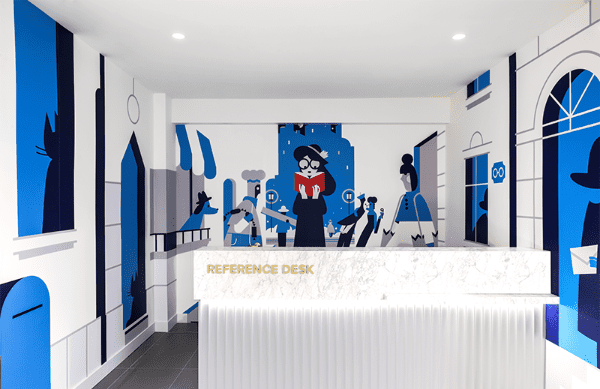Enriching environmental experience, Part two: How to use brand as a filter to localize your spaces

If you haven’t already, please check out Part l of this series: Integrating brand across physical spaces.
Physical space is an extension of brand—an area where a company’s personality, culture, and values come to life within four walls. But it’s not just an organization’s overarching identity that these environments should embody. To truly shine, offices, institutions, stores, and more also need to reflect their local surroundings. Because when the design of a physical space is considered through a local lens, it sparks a stronger connection with the community—and creates a more bespoke, relatable experience for customers, too.
Localized installations
Take, for instance, Warby Parker. The North American eyewear brand has built an empire on the promise of seamlessness, convenience, and affordability—as well as a commitment to social good. It’s particularly known for its one-for-one giving program, where, for every pair of glasses purchased, another is given to someone in need.
The business brings this same socially-conscious spirit into its physical spaces as well, through mural installations that employ local artists to decorate Warby Parker shops across the continent. With locations from Los Angeles to Louisville, Kentucky and Troy, Michigan to Toronto, the company recognized that rolling out carbon-copy stores isn’t the right approach. By commissioning professional muralists in each region to interpret the brand’s visual expression in their own way, Warby Parker succeeds in bringing a local flair to its many sites, while supporting the arts in the process—leading to retail environments that feel both unique and unified.


Warby Parker murals by local artists Andy Pizza and Roman Muradov in Columbus, Ohio and San Francisco.
Localized architecture and design
High-end skincare brand Aesop takes the concept of environmental localization to a new level. While other retailers may incorporate small touches into their physical spaces to honor the cities or towns in which they reside, Aesop bases its entire design around locality.
At Aesop, no two stores are the same: they’re created in partnership with different architects who integrate local materials and references into every boutique site. Its Upper West Side New York store, for example, maintains the original pressed metal façade and signage of the former tenant—a family-run French dry-cleaning business—and embraces the legacy of the space with shelving that resembles coat hangers. Through linear structures, sharp angles, and futuristic-looking furniture, the Geneva location pays homage to the modernness, luxury, and precise manufacturing for which the Swiss are known. And in Tokyo, Aesop’s Aoyama store captures the Japanese ethos of wabi-sabi—a concept that celebrates the imperfections of natural decay—through reclaimed wood and preserved concrete pieces of the building’s skeleton. However, within all its 200+ stores, Aesop weaves a steady throughline marked by minimalism, craftsmanship, and its own dedication to sustainability—so its highly tailored designs still feel aesthetically and philosophically consistent.
Learn more: Bringing brand to life in physical spaces



Aesop stores in New York, Geneva, and Tokyo look noticeably different – yet still feel related.
Localized programming
Retail’s physical spaces aren’t simply areas for customers to peruse products. For many brands, they serve as a hub for local events, as well. Apple is one such business. The tech giant believes its stores serve a purpose beyond point-of-sale interactions—which stems from their brand purpose, ‘Think Different.’ Since 2017, has been using them to hold “Today at Apple” sessions. This program offers lessons taught by Apple professionals and world-renowned artists on everything from photography to music to coding. And to make this initiative possible, Apple installed “Forum Displays”—mobile screens that create a video wall—within its many stores.
Although each location generally offers a wide range of classes, many are more localized by appealing to specific groups, like teachers, within the larger community. And some are even imbedded into very fabric of the city in which the store is situated—like photo or sketch walk classes that essentially take participants on tours of the surrounding neighborhoods.

Hip-hop producer RZA leads a “Today at Apple” session called the “Art of Beatmaking” in Brooklyn.
Localized products
Even in the digital era, physical space can play a key role for major retailers: enabling them to promote products and engage with customers in a way they may not be able to online—ultimately driving sales. Many national and global businesses stock a standard set of items across all their stores, so customers can buy the same chair, laptop, or shirt no matter where they are. Recently, though, some have begun to see their brick-and-mortar endeavors as a chance to create hyper-local shopping experiences for their clientele.
As part of its direct-to-consumer approach, Nike has done just that with its four Nike Live sites: small-format, members-only locations that use mobile app data to cater rotating merchandise to shoppers from the store’s specific geography. Instead of being inundated with every sneaker, jacket, or accessory Nike has in its inventory as you might be in a flagship location, Nike Live patrons receive a more curated, customized experience—helping to build a sense of community. The latest site, which opened in Nike’s hometown of Eugene, Oregon last year, takes this localization even further: serving as a meeting point for nearby running groups, offering select University of Oregon gear on its racks, and more. Here, the physical Nike Live store itself is a facilitator for the company’s brand strategy—which has continued to be met with much success.
Learn More: Integrating brand elements into physical space to elevate experience

Nike Live stores are smaller and feature merchandise that is curated to specific geographies.
Localized experiences
Similar to Warby Parker, CAMP—which dubs itself a “family experience company”—works to create a distinct environment in every one of its retail stores, from Dallas to Los Angeles to Boston. But instead of using art to lend a local flair to each of its sites, CAMP focuses on curating special experiences. While the toys and merchandise at the front of the floor may feel comparable no matter where shoppers are, each site has a “secret door” in the back that invites kids to explore different themed “camps” across locations.
From Art CAMP in Manhattan featuring a giant Jackson Pollock “splatter room” to Cosmic CAMP in Brooklyn, where participants encounter aliens and out-of-this-world habitats through interactive games and an immersive theater, every world behind the door is unique—even in the same city. Today, CAMP has also partnered with iconic children’s entertainment groups, including Disney and Paw Patrol-creator Spin Master Entertainment, to develop camps that honor beloved kids’ movies, shows, and characters. And on top of these experiences, the company also schedules one-time events like dance parties, comedy classes, and concerts. Here, the goal is less around designing concepts that are unique to a specific area or neighborhood, but rather about constantly rotating the itinerary and creating fresh experiences—so that, whether kids are visiting another store or returning to their hometown location, they’ll never, ever be bored.


Participants explore Cosmic CAMP at the store’s Brooklyn location.
Whether it’s a one-time painting created by a local artist or an ongoing analysis of a location’s offerings—there’s no one right way to “localize” a brand’s space. When you consider the ‘how’ through your brand strategy, even a small investment can make a big impact and provide consistency across your ecosystem of experiences.
Want to think up new ways to localize your space and align with your brand strategy? We’re on it. Reach out to learn how we can help your space achieve its full potential.



